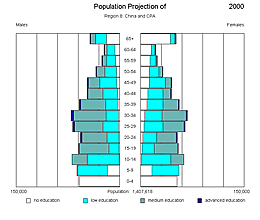 |
|
| |
|
Human Capital
Population Projections by Level of Education
Education is considered a crucial variable in explaining differences
in fertility behavior and differential patterns of mortality and migration.
At the same time, education is considered to be the best means of improving
the quality of human resources, thereby promoting economic development.
Population projections by level of education are an important step in
improving population forecasting and its relevance. Adding education to
age and sex as an explicitly considered demographic dimension in population
forecasting affects the demographic output parameters themselves due to
the fact that a significant source of so far unobserved heterogeneity
is being observed and explicitly endogenized. It may, therefore, be considered
an improvement of the purely demographic output parameters of the projection.
More importantly, however, due to the overriding substantive importance
of education, the future educational composition of the population is
of interest in its own right as it shapes the human capital component
of population.
Population projections by level of education have been applied by the IIASA World Population Program to many settings:
| Mauritius PDE Study (Lutz et al. 1994) | |
| Cape Verde PDE Study (Wils 1996) | |
| Cape Verde, Sudan, and Tunisia (Goujon and Wils 1996) | |
| North Africa (Yousif et al. 1996) | |
| Jordan, Lebanon, Syria, West Bank and Gaza Strip (Goujon 1997) | |
| Yucatan Peninsula (Goujon et al. 2000, pp.141-172) | |
| 13 world regions (Lutz and Goujon 2001) | |
| China by rural and urban area (Cao 2002, Cao 2000), by region (Toth et al. 2003). | |
| Indian States (Goujon and McNay 2003) |
We present here population projections by level of education for 13 world regions for the period 2000 to 2030. The demographic methodology of multi-state population projections has been applied. This method is based on a multi-dimensional expansion of the life table (increment-decrement tables) and of the cohort-component projection method developed at IIASA during the 1970s.

Example: Population Pyramid of China & CPA
(Move the mouse over the image to view animation
and description)
Educational Projection 2000-2030
ICDP Scenario
Region: China and CPAMale (left) & Female (right) by 5-year age groups
Starting population: 1,407,618
Projected population: 1,637,212
No education
Primary education
Secondary education
Tertiary education
The NEXT PAGE provides summarized information on:
| the definition of the 13 world regions | |
| the structure of the multi-state population projection model by level of education. | |
| the definition of the four educational categories | |
| the description of the three scenarios used for the projections | |
| and the assumptions by region, scenario, year, and education category by demographic indicators; and the results by 5-year age groups and by 5-year steps of the projection period 2000-2030 for the three above-mentioned alternative scenarios as downloadable Excel (*.xls) or Comma delimited (*.csv) spreadsheets. | |
| References |
To view more moving population pyramids by sex and educational groups, click here...
Correspondence and requests should be addressed to Anne Goujon (goujon@iiasa.ac.at).
![]()
Responsible for this page:Suchitra Subramanian
Last updated:
19 Sep 2011
Phone: (+43 2236) 807 0
Copyright © 2009-2011 IIASA